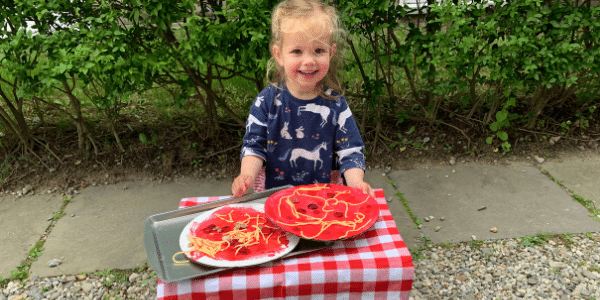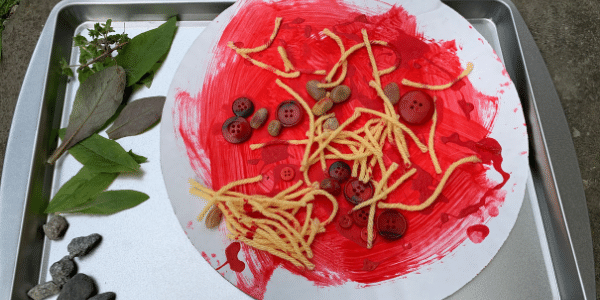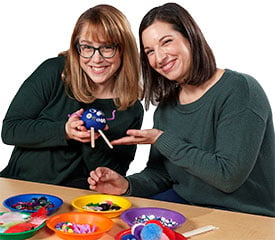Meaningful Praise

How to Praise Children's Artwork
“Wow, Hannah! I see you added red paint, yellow yarn, and buttons to your circle. I’m wondering what you were creating.”
“I made a pizza! I’m going to serve it to you now. You want a piece?”
“Yes, please! It looks delicious. Please tell me about the toppings you added. I see red buttons and some brown pebbles.”
“They are pepperoni and… more pepperoni!”
“Perfect! I’ll have a slice, please!”
This dialogue between caregiver and child illustrates the rich conversations that can come after giving specific and genuine feedback, also referred to as meaningful praise.
Why is meaningful praise so important? This type of feedback gives a child a sense of pride, boosts confidence, and can motivate children to work hard and have a healthy outlook regarding their abilities. They know you’ve noticed their details, can think about what they might add to make their work even better, and will more likely take creative risks when using materials in the future.

In the pizza example above, instead of saying “Wow! That’s really pretty,” you could say something such as “I notice you painted the middle of your circle all red and left the edges plain. You added pieces of yarn and buttons and pebbles to your work. Wow!” If the caregiver had simply said, “Good job!” and left it at that, think of all the opportunities for conversation and language that would have been missed. When non-specific praise is given, children often work only to gain positive feedback from their caregivers. Meaningful praise gives children knowledge about their own abilities, insight into their strengths, and intrinsic motivation to work and create.
When offering meaningful praise in response to a child’s work, a good place for teachers and caregivers to start is by commenting on what they see, not what they think they see or their opinions. Consider using the sentence starters, “I see…” “I wonder…” or “I notice…” to give a framework for commenting on children’s work.
Examples of Meaningful Praise
For example, if a child has glued feathers onto a piece of tagboard, here are some ways a caregiver might respond:
- I see you’re only choosing blue feathers.
- I notice all your feathers are touching.
- I notice you are carefully choosing certain feathers. I wonder why you are choosing the ones you picked.
For very young children and those with language challenges it can be helpful to offer either/or questions to support their language development. For example, if children are working on cutting strips of tape, a caregiver might say, “You’re cutting tape. Are you cutting the yellow tape or the green tape?” It can be helpful to point to the yellow and green tapes as you ask your question. If a child is drawing with crayons, you might ask “Will you use the blue crayon or the brown crayon?” Another strategy is to answer questions with questions, as this helps a child foster awareness and builds problem-solving skills.
When thinking about the tape example, some questions you could ask might be:
- What’s your plan?
- Can you use the tape in a different way?
- If children are having difficulty cutting the tape, caregivers could say “It seems like you’re having a hard time cutting the tape. Could you move the tape to a different place to make it easier to cut? Where could you move it?”
Why Meaningful Praise is Important
Early childhood teachers help build children’s confidence in their abilities by giving children the opportunity to problem-solve and figure out ways to successfully use materials themselves using guided questions.
When thinking about our own experiences as adults, this idea of meaningful praise still holds strong. When I was in grad school for teaching, my writing professor used to give the most wonderful and meaningful feedback. Instead of writing “Good job!” on her papers and simply assigning a grade, the professor would give very specific examples of what she noticed.
For instance, I wrote a creative writing paper about my new kitten. The feedback about my writing said things such as, “You used such descriptive language to describe your new kitten. I can really picture his orange fur and hear his loud purr when I read this passage.” Her specific language made me feel proud of my work, encouraged me to want to keep writing, and gave me the confidence to take risks with my work. Think about how you would feel if your boss at work were to tell you she’d noticed all the details and hard work you had done on a project - pretty great, right? Now think about that same work you had done and your boss only telling you “Good job,” or not giving you any feedback at all. Would you want to do better the next time? Take risks and challenge yourself? Maybe not.
Whatever you’re doing at home or in a classroom, whether it’s simple invitations you set up, free play with loose parts or toys, or taking a walk, commenting on exactly what you see happening, speaking to your children with respect and curiosity, and showing them attention, thoughtfulness, and love can really help them build confidence in their abilities and intrinsic motivation to explore and learn about their world.

With over 30 years of combined teaching experience between them, early childhood educators Nicole Werther and Rachel Miller know just how to keep your young children engaged—let them take the lead! Their small business, Backyartists, encourages creative thinking and discovery through the magic of process art and sensory play.
Rachel and Nicole are Becker's Creative Arts Content Advisors and have used their knowledge of process art to create resources, such as blog posts and activity ideas, to inspire teachers and parents when planning projects with the Artful Goods materials.
They also offer playgroups and classes in the Boston area. Check out Backyartists.com for the most up to date offerings.
